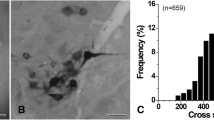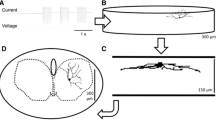Summary
The hypoglossal nuclei of adult male rats which had received left hypoglossal axotomies, were studied quantitatively by making area measurements of structures on twenty electron micrographs per hypoglossal nucleus. Boutons and dendrites were analysed in further detail by counting and measuring profiles, counting synaptic thickenings per profile, and counting degenerating profiles. Results of light microscopy were confirmed and extended. In injured nuclei, microglia increased from 2 days to 2 weeks after axotomy, wrapping around neuron perikarya and parts of the dendrites between boutons and their post-synaptic sites. As microglia diminished after 2 weeks, astrocyte processes increased and replaced them, reaching peak growth at 5 weeks after axotomy. From 7 days to 5 weeks after axotomy there were fewer synaptic junctions. Neurons became stripped of boutons, but dendrites retained some. Dendrites shrank and some degenerated. Boutons shrank and decreased in numbers. At 10 and 12 weeks, all parameters returned to normal, by which time the hypoglossal nerve had reconnected with the tongue.
Possibly the chronological succession from boutons to microglial processes to astrocyte processes to boutons covering the neuron perikarya reflects changes in the neuronal glycocalyx during repair.
Similar content being viewed by others
References
Blinzinger, K. andKreutzberg, G. (1968) Displacement of synaptic terminals from regenerating motorneurons by microglial cells.Zeitschrift für Zellforschung und mikroskopishe Anatomie 85, 145–57.
Gibbons, I. R. andGrimstone, A. V. (1960) On flagellar structure in certain flagellates.Journal of Biophysical and Biochemical Cytology 7, 697–716.
Hamberger, A., Hansson, H. -A. andSjöstrand, J. (1971) Surface structure of isolated nerve cell bodies. Detachment of nerve terminals during axon regeneration.Journal of Cell Biology 47, 319–31.
Haug, H. (1972) Stereological methods in the analysis of neuronal parameters in the central nervous system.Journal of Microscopy 95, 165–80.
Kirkpatrick, J. B. (1968) Chromatolysis in the hypoglossal nucleus of the rat: an electron microscopic analysis.Journal of Comparative Neurology 132, 189–212.
Peters, A., Palay, S. L. andWebster, H. De F. (1970)The fine structure of the nervous system: the cells and their processes. Hoeber, New York, Evanston and London.
Sumner, B. E. H. andWatson, W. E. (1971) Retraction and expansion of the dendritic tree of motor neurons of adult rats inducedin vivo.Nature (London) 233, 273–5.
Torvik, A. andSkjörten, F. (1971) Electron microscopic observations on nerve cell regeneration and degeneration after axon lesions. II Changes in glial cells.Acta Neuropathologica (Berlin) 17, 265–82.
Vaughn, J. E. andPeters, A. (1968) A third neuroglial cell type. An electron microscopic study.Journal of Comparative Neurology 133, 269–87.
Vaughn, J. E., Hinds, P. L. andSkoff, R. R. (1970) Electron microscopic studies of Wallerian degeneration in rat optic nerves. I. The multipotential glia.Journal of Comparative Neurology 140, 175–84.
Venable, J. H. andCoggeshall, R. (1965) A simplified lead citrate stain for use in electron microscopy.Journal of Cell Biology 25, 407–8.
Watson, W. E. (1965) An autoradiographic study of the incorporation of nucleic-acid precursors by neurons and glia during nerve regeneration.Journal of Physiology (London) 180, 741–53.
Watson, W. E. (1966a) Some quantitative observations upon the oxidation of substrates of the tricarboxylic acid cycle in injured neurons.Journal of Neurochemistry 13, 849–56.
Watson, W. E. (1966b) Alteration of the adherence of glia to neurons following nerve injury.Journal of Neurochemistry 13, 536–7.
Watson, W. E. (1966c) Quantitative observation upon acetylcholine hydrolase activity of nerve cells after axotomy.Journal of Neurochemistry 13, 1549–50.
Watson, W. E. (1968) Observations on the nucleolar and total cell body nucleic acid of injured nerve cells.Journal of Physiology (London) 196, 655–76.
Watson, W. E. (1970) Some metabolic responses of axotomised neurons to contact between their axons and denervated muscle.Journal of Physiology (London) 210, 321–43.
Watson, W. E. (1972) Some quantitative observations upon the responses of neuroglial cells which follow axotomy of adjacent neurons.Journal of Physiology (London) 225, 415–35.
Weibel, E. R. (1969) Stereological principles for morphometry in electron microscopic cytology.International Review of Cytology 26, 235–302.
Westrum, L. E. andBlack, R. G. (1971) Fine structural aspects of the synaptic organisation of the spinal trigeminal nucleus (pars interpolaris) of the cat.Brain Research 25, 265–87.
Author information
Authors and Affiliations
Rights and permissions
About this article
Cite this article
Sumner, B.E.H., Sutherland, F.I. Quantitative electron microscopy on the injured hypoglossal nucleus in the rat. J Neurocytol 2, 315–328 (1973). https://doi.org/10.1007/BF01104033
Received:
Revised:
Accepted:
Issue Date:
DOI: https://doi.org/10.1007/BF01104033




